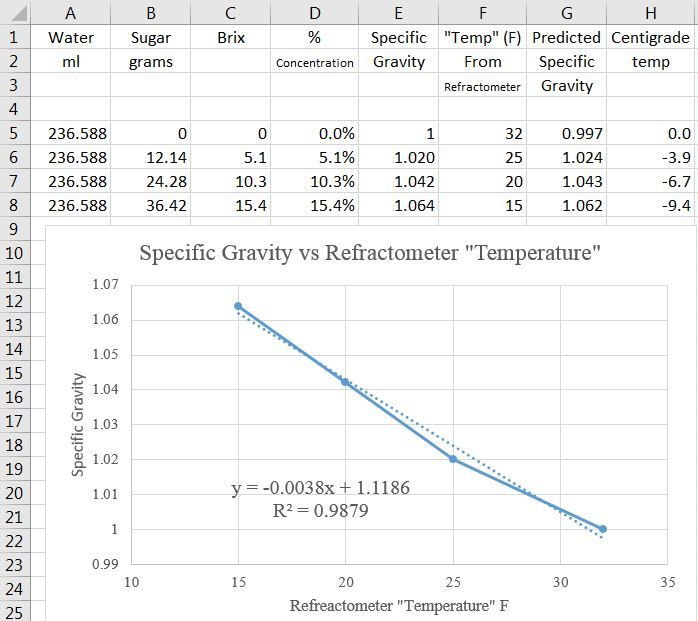I went looking for info on using a refractometer designed for estimating the freezing protection of automotive anti-freeze and effectiveness of battery electrolyte, to estimate the original specific gravity of starting fermentation liquids. I didn't find much. I did find one person from a thread in '06 https://www.homebrewtalk.com/showthread.php?t=101163 (see post #4) using an automotive refractometer, but he didn't provide his "decoding ring".
The specific model of refractometer I have is "7181 AO DUO-CHEK" made by American Optical Corportation, located in Buffalo N.Y. (At least when this one was made.)

I started with 8 oz of water (236.6ml) to which I added level tablespoons (12.14g) of granulated table sugar. The water was a little cooler than room temperature at 69F. I first checked the hygrometer and refractometer with de-ionized water (DI). I added one tablespoon of suger then measured specific gravity (SG) using the hygrometer, and then checked the "temperature" reading of the solution using the refractometer. I added a total of three tablespoons or 36.4g of sugar. Initial readings with DI water were 1.000 SG and "+32" degrees Fahrenheit on the refractometer. Each following reading taken after the addition of a tablespoon of sugar can be seen in the image of the spreadsheet below in cells E5-8 and F5-8 respectively:

A simple linear regression was calculated for the relationship of the hygrometer SG readings to the refractometer's "temperature" reading. While I was careful with measurements of water and sugar, the readings of SG and Temp were "eye-balled". Still, the fit of the model to the data is good with the square of the residuals being 0.9879. The values of SG predicted by the model are in cells G5-8 and can be compared to measured values in cells E5-8.
I have no hobby horse to ride here. Just presenting a set of data with some analysis for those that might be interested in using a tool they have in hand, like I was. Use my 'decoding ring' as 'you' see fit.
Paul
The specific model of refractometer I have is "7181 AO DUO-CHEK" made by American Optical Corportation, located in Buffalo N.Y. (At least when this one was made.)

I started with 8 oz of water (236.6ml) to which I added level tablespoons (12.14g) of granulated table sugar. The water was a little cooler than room temperature at 69F. I first checked the hygrometer and refractometer with de-ionized water (DI). I added one tablespoon of suger then measured specific gravity (SG) using the hygrometer, and then checked the "temperature" reading of the solution using the refractometer. I added a total of three tablespoons or 36.4g of sugar. Initial readings with DI water were 1.000 SG and "+32" degrees Fahrenheit on the refractometer. Each following reading taken after the addition of a tablespoon of sugar can be seen in the image of the spreadsheet below in cells E5-8 and F5-8 respectively:

A simple linear regression was calculated for the relationship of the hygrometer SG readings to the refractometer's "temperature" reading. While I was careful with measurements of water and sugar, the readings of SG and Temp were "eye-balled". Still, the fit of the model to the data is good with the square of the residuals being 0.9879. The values of SG predicted by the model are in cells G5-8 and can be compared to measured values in cells E5-8.
I have no hobby horse to ride here. Just presenting a set of data with some analysis for those that might be interested in using a tool they have in hand, like I was. Use my 'decoding ring' as 'you' see fit.
Paul


